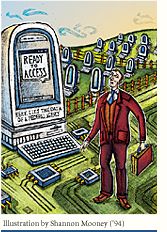 |
 |
||||||
|
|
|
|
|
The cybercemetery, which is the first of its kind, is sponsored by the university and the federal government and provides electronic access to anyone seeking information generated or collected by certain U.S. government agencies that are no longer operational. In 1997 the electronic records of the Advisory Commission on Intergovernmental Relations were the first to be placed on the web site. The agency, which among other activities tracked the flow of U.S. tax dollars, had closed down the year before. Prior to the records’ move to UNT, McGuire had to comb the UNT library as well as other libraries across the country and hound old professors to obtain the ACIR’s published research. “If the holdings of the ACIR had been available online when I began my search, it would’ve saved me a lot of time,” he says. McGuire has assisted in the project to store ACIR’s electronic and paper documents online for others. And it has benefited his counterparts around the world. When the cybercemetery was first developed, McGuire received an e-mail from a Swedish professor who was searching for the remaining records of the closed-down ACIR. Finding information about defunct agencies is “analogous to finding a book that’s out of print — just because it’s out of print doesn’t mean it isn’t worthwhile,” says McGuire.
A storage place in cyberspace Since 1948, UNT has been designated a U.S. federal depository library. It’s one of 1,300 libraries nationwide that provide the public with free access to government information. The creation of the cybercemetery is an electronic extension of the program. Although there are institutions that archive material for functioning agencies, there was no place to keep the information of defunct agencies before UNT created the cybercemetery. UNT approached the federal government about storing the electronic records of the defunct ACIR, says George Barnum, electronic collection manager with the U.S. Government Printing Office. “When that information was safely archived at UNT, we realized that agencies go away all the time and that this could be a really important role for the federal depository libraries,” Barnum says. “So, we broadened our original agreement with UNT for the ACIR to include other closed agencies, as needed.”
Making arrangements “As needed” has come to mean five agencies with thousands of files, and the number keeps growing. A 1997 Memorandum of Understanding between the university and the U.S. Government Printing Office created the cybercemetery as the prototype digital depository for accumulated information from defunct agencies. UNT ensures that the documents have come from the actual agencies and provides a free, public web site with a consistent address. UNT also seeks out other federal departments and agencies nearing their end to make arrangements to archive their documents in the cybercemetery. “Without the UNT cybercemetery, important information would just disappear when an agency passed out of existence,” says Melody Kelly, UNT documents librarian. “It’s so easy to hit the delete button with electronic documents, but that would cheat the public of the historic record and research of these agencies.” UNT will soon maintain the same type of web access for the Texas Register, a record of changes in state regulations and legislative action. McGuire sees the growth of the cybercemetery as a sign of the times ahead. “I just
remember the hoops I had to jump through to find the ACIR before
it came to UNT,” he says. “So it’s a blessing to see something like
this. The information isn’t just being put on a library shelf somewhere
to collect dust — it’s all online for everybody to use, and that’s
monumental.
|
|||||||||||

 FOR
SOME PEOPLE IT'S EBAY OR AMAZON.COM, but for Michael McGuire, UNT
assistant professor of public administration, one of the best web
sites on the Internet is UNT’s cybercemetery.
FOR
SOME PEOPLE IT'S EBAY OR AMAZON.COM, but for Michael McGuire, UNT
assistant professor of public administration, one of the best web
sites on the Internet is UNT’s cybercemetery. 